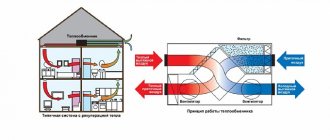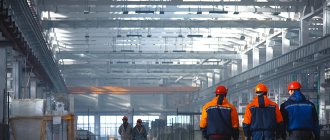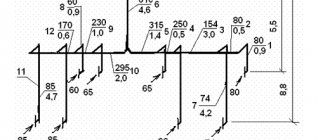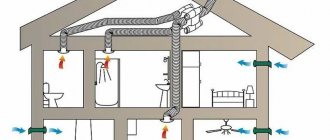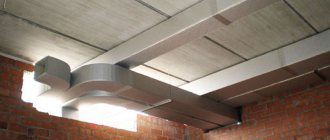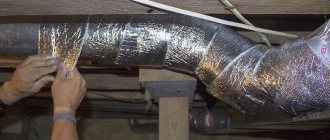What is heat recovery?
Heat recovery or heat recovery is a heat exchange process in which heat is taken from exhaust air and transferred to fresh injected air. Recovery is used using supply and exhaust units and central air conditioners with a recovery heat exchanger. The process takes place in a recovery heat exchanger in such a way that the exhaust and fresh air are completely separated from each other so that they do not mix.
In refrigerated rooms, recovery heat exchangers can also be used in the reverse way, that is, to recover cold. In this case, the cold from the exhaust air is transferred to the supplied air.
An important characteristic of recuperators is the Recuperation Efficiency Coefficient.
The heat recovery efficiency ratio expresses the ratio between the maximum possible heat recovered and the heat actually recovered. Theoretically, efficiency can vary from 30 to 90%. This characteristic depends on the cost, manufacturer and type of recuperator.
Methods for organizing recuperative ventilation
Recovery is arranged in one of the following ways: centralized and decentralized. In the first case, ventilation flows from the entire room pass through the heat exchanger, in the second - from one room.
Centralized complex – air handling unit
A centralized system is installed at the stage of construction or major modernization of the ventilation system.
A forced supply and exhaust unit (PVU) with a built-in recuperator is selected. The main selection criterion is the overall performance of the complex based on the entire volume of air in the structure (+)
A PVU with a recuperator ensures sufficient air exchange even in houses with sealed windows. At the same time, air flows are distributed evenly without creating drafts.
Complex supply and exhaust units of monoblock type are equipped with:
- fans – round-the-clock supply of clean air and emission of jets saturated with carbon dioxide;
- heaters – preheating of inflow;
- filters – retain dust and microparticles;
- recuperator - different types of installations can be used.
The functionality of some PVUs is expanded with a delay timer, power regulator, humidity level sensors, etc.
The body of monoblock models is covered with noise-absorbing material, making the operation of the PVU very quiet. Vertical, horizontal and suspended versions of ventilation units are possible
Vents (Ukraine), Dantherm (Denmark), Daikin (Japan), Dantex have proven themselves well .
Design and principle of operation of supply and exhaust ventilation with heat recovery
To ensure constant air exchange in the room, clean the incoming air from dust and raise the temperature in a private house or apartment, it is necessary to install forced ventilation. Supply and exhaust ventilation with heat recovery supplies purified air. Thermal energy savings at rated power are about 6 kW. A recuperator is a device that returns heat to the house. It belongs to the category of volatile structures and requires connection to a source of electrical energy.
When designing, the following is taken into account:
- Number of rooms in the house;
- Expected number of people;
- Purpose of the premises.
The calculation of the air duct network throughout the house is made based on the pressure loss that is present in the ventilation system. In a building with a forced supply and exhaust ventilation system installed, the air flow comes from the street. When passing through the condensing unit, the air is cleaned of dust, heated to the required temperature and supplied to the room. The advantage of the system is that purified and heated air is supplied to the house in the required volume.
The process works around the clock:
- Air from the street enters through the ventilation duct through the silencer into the ventilation unit;
- In the unit, the air is cleaned of dust, heated and supplied through a silencer through the ventilation duct into the room;
- Exhaust air from bathrooms and utility rooms returns back to the ventilation unit and transfers its heat to the incoming air, which comes from the street;
- Passing through the ventilation unit, the already cooled and exhausted air exits onto the roof of the street.
Using the built-in control panel you can configure:
- Incoming air temperature;
- Fan speed required for air exchange;
- The filter replacement interval is adjustable by week.
If it is necessary that there be less air exchange at night or on certain days of the week, appropriate settings are made. For example,
- The temperature of the incoming air into the supply unit is -9◦C;
- Air temperature supplied to the room +15◦C;
- The temperature of the exhaust air leaving the unit is -3◦C.
In this mode, the air heater (heater) inside the supply column is turned off—electricity is not wasted to heat the air. This ensures thermal energy savings.
The feasibility of a recuperator in ventilation
We can talk about the feasibility of installing recuperative ventilation by assessing the effectiveness of the system and comparing its advantages with disadvantages.
Part of the heat is taken from the exhaust air drawn outside and transferred to forced fresh jets directed inside the room. This allows you to reduce heat loss by up to 70% (+)
The need to use heat recovery is most relevant in buildings with forced air exhaust. As a rule, these are low-inertia buildings erected using innovative thermal insulation technologies (houses made of sandwich panels, gas silicate slabs, foam blocks).
In such buildings, the walls do not accumulate heat well, and natural air exchange is ineffective.
However, problems with air circulation are also typical for “traditional” buildings made of brick and concrete. The presence of sealed heat-sound-insulating PVC windows blocks circulation with a natural impulse - the flow of fresh air stops, and the draft in the ventilation duct overturns or tends to zero.
The solution to the problem of “Euro-windows” is the organization of forced ventilation. The system restores air exchange, but heat loss increases up to 60%. And here it is no longer possible to do without heat recovery.
The efficiency of the exchange process is expressed as a percentage and shows the amount of heat expended from the exhaust air to heat the fresh “intake”
Ventilation heat recovery efficiency indicator:
- 0% - open window - warm air is removed into the atmosphere, and cold air enters, lowering the temperature in the room;
- 100% - the supply air is heated to the “exhaust” temperature - technically impossible to implement;
- 30-90% - an acceptable parameter, recovery with an efficiency of 60% or more is considered good, an efficiency of over 80% is excellent heat transfer.
The efficiency of the system depends on the type of recuperator, room dimensions and air flow. In any case, the use of recovery ventilation, even with an efficiency of 30%, is more profitable than its absence. In addition to significant savings on energy resources, heat “regeneration” improves the overall microclimate in the room.
Disadvantages of using a heat exchanger:
- Energy dependence. The purchase of climate control equipment is justified if the electricity consumption is significantly less than its savings after installing the recuperator.
- Condensation. Due to temperature differences, moisture may condense on the walls of the heat exchanger. In winter, there is a possibility of icing, which can lead to a rapid decrease in efficiency or failure of the recuperator.
- Noisy work. Some models emit a hum during operation. If during the day this disadvantage is not particularly noticeable, then at night the noise causes discomfort. Recuperators with improved insulation operate quietly.
High initial investment is often the main argument against energy efficient ventilation.
It is advisable to invest money in a system that will pay off within 5-8 years. It should be taken into account that additional costs will have to be incurred to maintain the complex, for example, periodic replacement of fans
Design features
Recovery in ventilation is a fairly new technology. Its action is based on the ability to use the removed heat to heat the room. This happens thanks to separate channels, so the air flows do not mix with each other. The design of recuperative units can be different; some types avoid the formation of condensation during the heat transfer process. The performance level of the system as a whole also depends on this.
Ventilation with heat recovery can produce high efficiency during operation, which depends on the type of heat recovery unit, the speed of air flow through the heat exchanger and how large the difference between the temperature outside and inside the room is. The efficiency value in some cases, when the ventilation system is designed taking into account all factors and has high performance, can reach 96%. But even taking into account the presence of errors in the operation of the system, the minimum efficiency limit is 30%.
The purpose of the recuperative unit is the most efficient use of ventilation resources to further ensure sufficient air exchange in the room, as well as energy savings. Taking into account the fact that supply and exhaust ventilation with recovery operates most of the day, and also taking into account that ensuring a sufficient air exchange rate requires considerable equipment power, the use of a ventilation system with a built-in recovery unit will help save up to 30% of energy.
The disadvantage of this technique is its rather low efficiency when installed over large areas. In this case, electricity consumption will be high, and the performance of the system aimed at heat exchange between air flows may be noticeably lower than the expected limit. This is explained by the fact that air exchange occurs much faster in small areas than in large objects.
Types of recuperative units
There are several types of equipment used in the ventilation system. Each of the options has advantages and disadvantages, which must be taken into account even when forced ventilation with recovery is just being designed. There are:
- Recuperator plate mechanism. It can be made on the basis of metal or plastic plates. Along with fairly high performance (efficiency is 75%), such a device is susceptible to icing due to the formation of condensation. The advantage is the absence of moving structural elements, which increases the service life of the device. There is also a plate type of recuperative unit with moisture-permeable elements, which eliminates the possibility of condensation. A feature of the plate design is that there is no possibility of mixing two air flows.
- Ventilation systems with heat recovery can operate on the basis of a rotor mechanism. In this case, heat exchange between air flows occurs due to the operation of the rotor. The productivity of this design increases to 85%, but there is a possibility of air mixing, which can bring odors back into the room that are removed outside the room. The advantages include the ability to additionally dehumidify the air environment, which makes it possible to use equipment of this type in special-purpose rooms with an increased level of importance, for example, in swimming pools.
- The chamber mechanism of the recuperator is a chamber that is equipped with a movable damper, which allows odors and contaminants to penetrate back into the room. However, this type of design is very productive (efficiency reaches 80%).
- Recuperative unit with intermediate coolant. In this case, heat exchange occurs not directly between two air flows, but through a special liquid (water-glycol solution) or plain water. However, a system based on such a node has low performance (efficiency below 50%). A recuperator with an intermediate coolant is almost always used to organize ventilation in production.
- Regenerative unit based on heat pipes. This mechanism works using freon, which tends to cool, which leads to the formation of condensation. The performance of such a system is at an average level, but the advantage is that there is no possibility of odors and contaminants penetrating back into the room. Ventilation in an apartment with recuperation will be very effective due to the fact that it is necessary to serve a relatively small area. To be able to operate such equipment without negative consequences for it, it is necessary to select a model based on a recuperative unit that eliminates the possibility of condensation. In places with a fairly mild climate, where the air temperature outside does not reach critical levels, the use of almost any type of recuperator is allowed.
Types of recuperators
1. Plate recuperators
Exhaust and supply air pass through both sides of a series of plates. In plate heat exchangers, a certain amount of condensate may form on the plates, which is why they are equipped with condensate drains. Condensate collectors have a water seal that prevents the fan from capturing and delivering water into the channel. Due to condensation, there is a serious risk of ice formation during the cold season. Plate recuperators are characterized by high efficiency (50-80%), are the most common and relatively cheap, and are widely used in small enterprises and small buildings, cottages, and shops.
2. Rotary recuperators
Heat is transferred by a rotor rotating between the exhaust and supply channels. This is an open system, and therefore there is a high risk that dirt and odors can move from the exhaust air to the supply air, however, some manufacturers claim that mixing is eliminated in their recuperators. The level of heat recovery can be adjusted by the rotor speed. They have the highest efficiency (75-90%), and accordingly the price. Mainly used in large industrial enterprises, workshops, and large buildings.
3. Recuperators with intermediate coolant
Water or a water-glycol solution circulates between two heat exchangers, one of which is located in the exhaust duct and the other in the supply duct. The coolant is heated by the exhaust air and then transfers heat to the supply air. The coolant circulates in a closed system and there is no risk of transfer of contaminants from the exhaust air to the supply air. Heat transfer can be regulated by changing the circulation rate of the coolant. These recuperators have low efficiency (45-60%). Possessing low efficiency, they are used when the removed air is heavily polluted or toxic, when mixing is unacceptable.
4. Chamber recuperators
The chamber is divided into two parts by a shutter. The exhaust air heats one part of the chamber, then the damper changes the direction of the air flow so that the supply air is heated by the heated walls of the chamber. Contamination and odors can be transferred from the exhaust air to the supply air. Characterized by high efficiency (70-80%).
5. Heat pipes
This recuperator consists of a closed system of tubes filled with freon, which evaporates when heated by the removed air. When the supply air passes along the tubes, the vapor condenses and turns back into liquid. Has low efficiency (50-70%).
Technical characteristics that you should pay attention to when choosing
- Metal devices are effective in operation down to -10ºС. At low temperatures, performance decreases noticeably. As a result, electric pre-heating elements are used;
- When choosing, you should study the thickness of the case and the material of the cold bridges. The thickness of 3 cm is subject to additional insulation when the outside temperature drops below -5ºС. You will have to doubly use insulating material if the frame is made of aluminum;
- Particular attention should be paid to the free pressure indicators of the fans. It may happen that at 500 m3 the pressure may be completely absent. Consumers usually find out about this when the recuperator fails;
- It’s a big plus when additional functions can be connected to the automatic system. Thanks to improved automation, operating costs are reduced and the performance of the entire device is improved;
- The main indicator for deciding which recuperator to choose is ventilation pressure and power. A preliminary calculation is made of how much air should enter the house in one hour.
What are the advantages of a ventilation system with recovery?
As we have noted more than once, the main advantage of such a system is the ability to control the interaction of air inflow and outlet. Due to this, we significantly reduce ventilation heat loss, although we continue to saturate the room with fresh air.
Now let's talk in more detail about each of the advantages of ventilation systems with recovery.
Efficiency . Natural air removal is not always a convenient solution, because we become dependent on circumstances, environmental conditions, and temperature differences. In this regard, it is much easier to use a ventilation system with recovery, which can force air. A simple example of forced ventilation is a kitchen hood. More complex devices are capable, among other things, of getting rid of excess moisture. But this is simple exhaust equipment. In our case, we are talking about supply and exhaust systems that are capable of organizing the movement of air flows in both directions at once, mixing them and forming the necessary temperatures for a comfortable stay of a person in the room, that is, recuperating air.
Profitability . It should be noted that recuperation systems can recoup their cost through savings on heating and electricity. Costs are significantly reduced, sometimes by 5 times, that is, you are already paying 80% less than usual. Ask your friends how much it costs them to heat a country house if you don’t have one. The numbers will be impressive. Imagine how much money recovery ventilation can save. If inexpensive elements wear out, they can be replaced without negative consequences. During the warm season, you can save on climate control equipment, while simultaneously reducing emissions of harmful substances into the atmosphere. Yes, even from an environmental point of view, you are causing significantly less damage to the environment, because, among other things, you are reducing the load on the network. And don’t let it seem to you that one person is too little. Firstly, these are quite serious amounts of energy. Secondly, more and more people are switching to ventilation with recovery over the years.
Practicality . Ventilation systems with recovery are usually small in size, which means they are easy to install. Such equipment can be located in the bathroom, in the closet, and built into the ceiling. Today there are a huge variety of models to suit all tastes. So you don't have to worry about the interior.
Operation of air exchange with air heating
The principle of ventilation with recovery
Supply and exhaust ventilation with heat recovery solves three main problems:
- providing the premises with fresh air;
- return of thermal energy leaving with air through the ventilation system;
- preventing cold streams from entering the house.
The process can be schematically illustrated using an example. Organization of air exchange is necessary even on a frosty winter day with a temperature outside the window of -22°C. To do this, the supply and exhaust system is turned on and the fan is running, forcing air from the street. It seeps through the filter elements and, already cleaned, enters the heat exchanger.
As the air passes through it, it has time to warm up to +14-+15°C. This temperature may be considered sufficient, but does not meet sanitary standards for living. To achieve room temperature parameters, it is necessary to bring the air to the required values using the reheating function to +20°C in the recuperator itself using a heater (water, electric) of low power - 1 or 2 kW. With such temperature indicators, air enters the rooms.
The heater operates in automatic mode: when the outside air temperature drops, it turns on and operates until it heats up to the required values. At the same time, the waste stream is already heated to a “comfortable” 18 or 20 degrees. It is removed using a built-in ventilation unit, having previously passed through a heat exchange cassette. In it, it gives off heat to the oncoming cold air from the street, and only then goes into the atmosphere from the recuperator with a temperature of no more than 14-15°C.
Attention! The installation of metal-plastic structures disrupts the natural supply of fresh air flows into an apartment or house. The problem is solved by a forced system that supplies unheated air from the street, but also negates the energy saving efficiency of plastic windows. Supply and exhaust ventilation with a recuperator is a comprehensive solution to the heating problem with simultaneously functioning air exchange, an active method of energy conservation.
How to choose ventilation units with heat recovery
What should you remember when choosing ventilation with recovery? You need to buy such equipment so as not to regret it, so ask the seller about the following nuances:
First of all, ask the seller the following questions:
Question 1 . Who is the manufacturer of this air recovery ventilation? How long has this company been in business, what reputation does it have, what else does it produce?
Question 2 . How productive is this ventilation with air recovery?
Here you will need a specialist who can make a detailed calculation based on the characteristics of your premises. It is clear that buying supply and exhaust ventilation with heat recovery for an apartment and a three-story house is not the same thing.
Question 3 . What will be the resistance of the system to air flows after installing this equipment?
Here again you will need specialist advice. It is important not to just limit yourself to some general characteristics indicated in the table from the Internet, but to make a detailed calculation, for example, taking into account the number of bends in the air duct and many other nuances. The ratio of air flow to system resistance is one of the most important selection factors.
Question 4 . How expensive will it be to maintain ventilation with this recuperator? What is its energy class? What are the savings when using this device?
Question 5 . What are the Efficiency Coefficients of this recuperator for ventilation? Note that we say “coefficients” and not “coefficient”. Why? Is he really not alone? Not really. There is a declared one - this is some average value. And there is real efficiency, which is an objective indicator. What does it depend on? There are many factors. Here is the humidity and air, and how the system is organized, and the temperatures inside and outside.
Here are some recommendations for calculating the efficiency of a recuperator:
- If there is a paper heat exchanger, the efficiency will be from 60 to 70 percent. What does this mean for us? Is it good or bad? This means that ventilation with air recovery is resistant to freezing, although not one hundred percent.
- If there is an aluminum heat exchanger, the efficiency will be no more than 63%, while the efficiency of the air recuperator will be from 42 to 45% percent. Thus, you will have to use a significant amount of electricity to get rid of the frost.
- A rotary air recuperator has excellent efficiency indicators, but provided that it is controlled automatically, based on the readings of special sensors. However, these recuperators can freeze in the same way as aluminum ones, which reduces efficiency.
What else should you consider when choosing a recuperator for ventilation?
First . You are unlikely to find a supply and exhaust air recuperator that can effectively cope with work at temperatures below minus ten degrees Celsius. Don't trust the promises on labels and the assurances of sellers. The best option is a metal recuperator for ventilation, capable of coping with its task at that same -10 ºС. At lower temperatures, the recuperator simply stops working effectively. And if advertising promises you that this device is capable of functioning at -50 ºС, then, quite possibly, it is so, but with one caveat - this is more of an appearance of activity than real recovery. In any case, the efficiency will decrease, the air recuperator will freeze, so do not believe the promises of 100% efficiency and efficiency up to 99% - this is all just an advertising gimmick and deception that has nothing to do with reality.
Second . Look at the thickness of the case and the material. The fact is that thin cases freeze very quickly. For example, 3 centimeters is an insignificant obstacle to the cold. It's more about the name of the case than any effectiveness. It's the same with the material. The same aluminum - the coating is useless unless an additional layer of insulation is applied on top of it, or better yet, more than one. Otherwise, you just get an effective conductor for cold, which will very quickly freeze the equipment, and ventilation with recovery will stop working or begin to demonstrate very low efficiency.
Third . Pay attention to such an indicator as the free pressure of the fans. The fact is that the characteristic “500 m³” means nothing when “0 Pa” is indicated next to it. You may be deceived by large figures, which are actually incredible under the operating conditions that are typical for an ordinary residential building in Russia. In other words, they are writing to you about how ventilation with recovery can work in some ideal circumstances that you will never physically be able to provide for it. Thus, we are talking about a hypothetical ability, and not the real capabilities of the system.
Fourth . Switching modes and options is a useful thing, because it allows you to achieve significant savings in energy resources. Of course, you can monitor the temperatures yourself and quickly adjust the equipment to suit them, but sensitive sensors and automation will do this much better.
Fifth . The main parameter when choosing equipment for ventilation with recovery is the volume of air that enters the room in one hour. The optimal amount is at least 60 cubic meters per person. If there are two of you in the apartment - there are no less than 120, etc. Make sure that the equipment you are thinking of purchasing can actually provide this amount of air flow. If not, then don’t waste your money or time on purchasing it and find something suitable for your conditions. In addition to the performance itself, it is worth paying attention to the pressure that the fans have.
